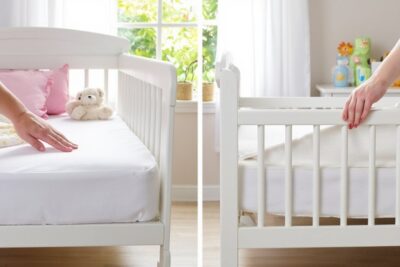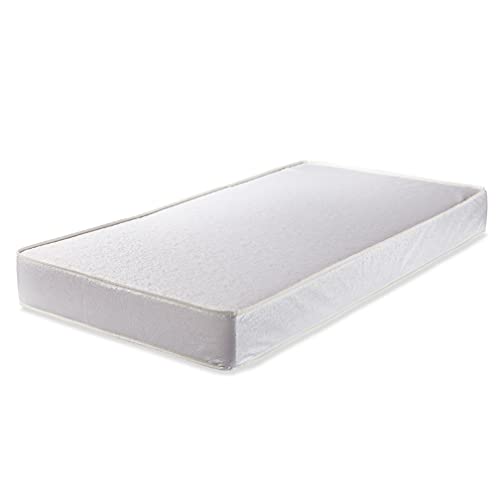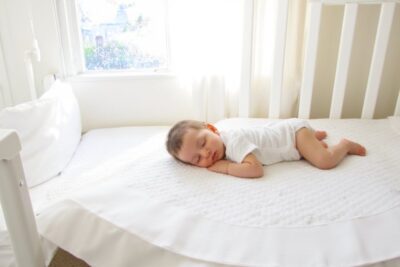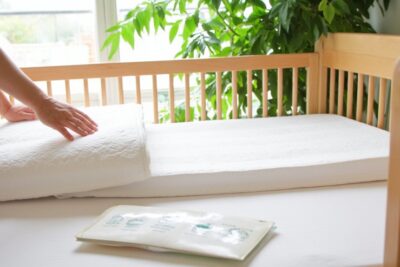
Best Crib Mattresses for Convertible Cribs

When choosing the best crib mattress for convertible cribs, prioritize firm, snug-fitting designs that reduce SIDS risks and support healthy growth from infant to toddler. Look for hypoallergenic, non-toxic materials with certifications like Greenguard Gold or GOTS to guarantee safety. Waterproof or removable covers help keep things clean. Brands like Naturepedic and Moonlight Slumber offer dual-sided options for versatile comfort. If you want to guarantee lasting safety and comfort, there’s more to explore about mattress materials, certifications, and maintenance tips.
- Main Points
- Why Choosing the Right Crib Mattress Matters
- Key Safety Features for Convertible Crib Mattresses
- Top Materials Used in Convertible Crib Mattresses
- Benefits of Organic and Non-Toxic Mattresses
- How to Ensure a Snug Fit in Convertible Cribs
- Comparing Innerspring vs. Foam Mattresses for Toddlers
- The Role of Mattress Firmness in Infant and Toddler Sleep
- Waterproof and Easy-to-Clean Mattress Options
- Certifications to Look for When Buying a Crib Mattress
- Transitioning From Infant to Toddler Mattress Surfaces
- Popular Brands and Models Recommended by Parents
- Frequently Asked Questions
- Final Thoughts
Main Points
- Choose dual-sided mattresses offering firm infant and softer toddler surfaces to fit convertible cribs' evolving needs.
- Opt for mattresses with certifications like Greenguard Gold and GOTS to ensure safety and organic material use.
- Prioritize firm, high-density foam or innerspring mattresses to reduce SIDS risk and support healthy spinal development.
- Select mattresses with waterproof, removable covers for easy cleaning and hygiene maintenance in convertible crib settings.
- Consider lightweight, manageable mattresses from trusted brands like Naturepedic, Moonlight Slumber, Avocado, and Babyletto.
Why Choosing the Right Crib Mattress Matters
Because your baby's safety and comfort depend on it, choosing the right crib mattress is essential.
You want a crib mattress that’s firm to reduce the risk of Sudden Infant Death Syndrome (SIDS) and fits snugly to prevent any gaps that could be hazardous. The tight fit design helps minimize movement and enhances stability, ensuring a secure and safe sleep environment for your baby.
Opt for mattresses made without harmful chemicals and those with organic certifications to protect your baby’s health by minimizing exposure to volatile organic compounds (VOCs).
A waterproof cover or built-in waterproof layer helps maintain hygiene and extends the mattress’s lifespan by guarding against spills and leaks.
If you’re using a convertible crib, consider dual firmness options, designed for infants and toddlers, ensuring lasting comfort and safety as your little one grows.
Selecting thoughtfully shows your commitment to nurturing and protecting your baby.
Key Safety Features for Convertible Crib Mattresses

Guaranteeing your convertible crib mattress has key safety features is vital for protecting your baby at every stage.
Start by choosing a crib mattress with a firm surface, as pediatricians recommend this to reduce SIDS risk by preventing indentations. For added peace of mind, look for mattresses that use hypoallergenic, non-toxic materials to ensure your baby's environment is safe and healthy.
Verify it meets federal safety standards and holds certifications like Greenguard Gold, which confirms low VOC emissions and safe materials.
A dual-sided design offers versatility, providing a firm side for infants and a softer one for toddlers, supporting healthy development.
Waterproof protection is essential for hygiene and durability, guarding against leaks and spills.
Finally, consider a lightweight design—easier for caregivers to handle during sheet changes and shifts—promoting both convenience and safety.
Prioritizing these features guarantees your baby rests on a secure, healthy mattress.
Top Materials Used in Convertible Crib Mattresses

When choosing a convertible crib mattress, you’ll find options made from both organic and synthetic materials, each with its own benefits and considerations.
Organic materials like cotton, wool, and natural latex offer natural safety and sustainability, while synthetic options often include certified foams designed to minimize chemical exposure.
Understanding these differences helps you pick a mattress that balances comfort, safety, and durability for your growing child.
Common Mattress Materials
Although choosing the right mattress material can feel overwhelming, understanding the common options helps you make a safer, more informed decision for your convertible crib.
Here are four primary materials to take into account:
- Polyurethane foam: Lightweight and affordable, but watch for VOC emissions and chemical exposure. Many parents look for CertiPUR-US certification to ensure the foam is free from harmful chemicals.
- Innerspring coils: Steel coils offer firm support, with 135-150 coils recommended for infant safety.
- Organic cotton: GOTS-certified organic cotton provides non-toxic properties and a breathable choice for sensitive babies.
- Natural latex: Durable and naturally hypoallergenic, offering firm support without harmful chemicals.
Each material affects firmness, durability, and safety differently.
Prioritize non-toxic properties and breathability when choosing your crib mattress to guarantee a healthy sleep environment for your little one.
Organic vs. Synthetic
Because your baby's safety and comfort depend heavily on mattress materials, choosing between organic and synthetic options requires careful consideration. Organic mattresses use natural fabrics like organic cotton and wool, certified by the Global Organic Textile Standard (GOTS) and GREENGUARD Gold to guarantee safe sleep free from chemical flame retardants and volatile organic compounds (VOCs). Synthetic materials, often polyurethane foam, may emit VOCs and contain chemical flame retardants linked to health risks. Though pricier, organic mattresses offer durable materials built to last through toddlerhood. Synthetic mattresses are lighter and budget-friendly but might compromise safety. Review this comparison to decide what suits your family best:
| Feature | Organic Mattresses | Synthetic Materials |
|---|---|---|
| Certifications | GOTS, GREENGUARD Gold | Often none |
| Chemical Exposure | Minimal VOCs, no flame retardants | Possible VOCs, chemical flame retardants |
| Durability & Cost | Durable, higher cost | Less durable, lower cost |
Benefits of Organic and Non-Toxic Mattresses

You’ll want to choose an organic and non-toxic mattress to reduce your baby’s exposure to harmful chemicals and volatile organic compounds, which can affect their health.
These mattresses often use natural materials that improve breathability and comfort while avoiding synthetic chemicals linked to respiratory and neurological risks.
Plus, opting for such mattresses supports environmental sustainability through the use of renewable resources and responsible manufacturing.
Health Advantages
When selecting a crib mattress, choosing organic and non-toxic options helps reduce your baby’s exposure to harmful chemicals that can affect their health.
These mattresses use natural materials and meet strict flammability standards without relying on toxic flame retardants. Certifications like GREENGUARD Gold and Certified Organic guarantee low VOCs and safe sleep environments for your infant.
Here are four key health advantages:
- Reduced exposure to harmful chemicals linked to respiratory and developmental issues.
- Lower volatile organic compound (VOC) emissions, minimizing respiratory irritants.
- Use of natural materials like wool promotes temperature regulation and moisture-wicking.
- Compliance with strict flammability standards without toxic additives guarantees safer sleep.
Choosing these mattresses supports your commitment to providing a nurturing, health-conscious sleeping space.
Environmental Impact
Beyond the health benefits, selecting an organic and non-toxic crib mattress also supports environmental sustainability.
When you choose organic crib mattresses made with certified organic cotton and natural materials, you reduce reliance on synthetic chemicals and petroleum-based products. Non-toxic mattresses free of harmful flame retardants help lower indoor air pollution by minimizing volatile organic compounds (VOCs).
Look for certifications like GREENGUARD Gold, which guarantee adherence to strict environmental standards. Many brands source materials from environmentally responsible suppliers practicing sustainable forestry, decreasing carbon emissions.
Additionally, durable mattresses designed to last through infant and toddler stages reduce waste and promote long-term sustainability.
By prioritizing these factors, you not only protect your child’s health but also contribute to a healthier planet, ensuring your choice serves both your family and the environment responsibly.
How to Ensure a Snug Fit in Convertible Cribs

Guaranteeing a snug fit between your mattress and convertible crib is essential for your baby's safety. A properly sized crib mattress prevents gaps that could pose risks like entrapment or suffocation.
To achieve this snug fit, follow these tips:
- Measure the convertible crib and confirm it matches standard crib mattress dimensions (27.25 x 51.6 inches), or check the manufacturer’s specifications for unique sizing.
- Verify the mattress leaves no more than a two-finger gap on the infant side to maintain safety standards.
- Choose a mattress with appropriate weight (6 to 20 pounds) to facilitate easy changing sheets and repositioning. Opting for a mattress with dual-sided design can provide both firm infant support and softer toddler comfort, ensuring long-term usability as your child grows.
- Verify certifications like GREENGUARD Gold to confirm the mattress complies with safety standards for convertible cribs.
This careful approach guarantees your baby rests safely and comfortably.
Comparing Innerspring vs. Foam Mattresses for Toddlers
When choosing between innerspring and foam mattresses for your toddler, consider that innerspring models offer firm support and better breathability, which can promote safer and cooler sleep.
Foam mattresses, on the other hand, tend to be lighter and provide softer contouring, but their durability and airflow may vary based on quality.
Weighing these factors will help you find the best fit for your child’s comfort and safety.
Innerspring Mattress Benefits
Innerspring mattresses provide toddlers with firm, reliable support thanks to their steel coil construction, which holds up well against the weight and movement of active children.
Choosing an innerspring mattress for your convertible crib enhances toddler safety by offering a firm surface that prevents dangerous sinking or indentations. Many innerspring mattresses are also certified for low chemical emissions, contributing to a healthier sleep environment for your child.
Consider these benefits:
- Dual-sided design meets infants’ and toddlers’ developmental needs.
- Better airflow helps regulate temperature, keeping your child comfortable.
- Superior support and durability withstand daily use and growing weight.
- Longer-lasting investment compared to foam mattresses, maintaining shape and firmness.
The Role of Mattress Firmness in Infant and Toddler Sleep
Three key reasons highlight why mattress firmness plays an essential role in infant and toddler sleep.
Ensuring a firm sleep surface supports SIDS safety by reducing suffocation risks during infant sleep.
Dual-sided mattresses offer the perfect balance, with a firm side for infants and a softer side for toddlers, adapting to your child’s changing needs.
Maintaining consistent mattress firmness promotes healthy spinal development, preventing infants from sinking into crib mattresses.
Here’s what you should focus on:
- Choose crib mattresses with high-density foam or innerspring for firm sleep surfaces.
- Avoid mattresses that indent or conform to your infant’s shape.
- Opt for dual-sided mattresses to support infant and toddler sleep phases.
- Prioritize firmness to enhance safety and developmental health.
Waterproof and Easy-to-Clean Mattress Options
When you choose a crib mattress, waterproof and easy-to-clean features are crucial to maintaining a hygienic sleep environment for your child. Both the Naturepedic and Moonlight Slumber mattresses have waterproof layers and removable covers that make cleaning simple. If your crib mattress lacks built-in waterproofing, like some organic cotton options, using a mattress protector is imperative to prevent stains and moisture damage.
| Mattress Model | Waterproof Feature | Cleaning Ease |
|---|---|---|
| Naturepedic Organic Mattress | Built-in waterproof layer | Removable, machine-washable cover |
| Moonlight Slumber Little Dreamer | Waterproof surface | Removable, machine-washable cover |
| My Green Mattress Emily Natural | No waterproof layer | Requires mattress protector |
| Organic Cotton Mattresses | Varies | Use mattress protector |
| General Protection Advice | Waterproof mattress protector | Extends mattress lifespan |
Prioritize waterproof, easy-to-clean mattresses for a healthier sleeping space.
Certifications to Look for When Buying a Crib Mattress
Certifications provide a reliable way to verify the safety and quality of a crib mattress, helping you make an informed choice for your baby’s sleep environment.
Certifications ensure your crib mattress meets safety and quality standards for a healthier baby sleep environment.
When selecting a mattress, consider these certifications:
- Greenguard Gold Certification guarantees low volatile organic compounds (VOCs), promoting a healthier indoor air quality.
- Global Organic Textile Standard (GOTS) verifies the use of at least 95% organic materials, free from harmful chemicals.
- CertiPUR-US certification confirms that foam components meet strict standards for emissions, durability, and chemical safety.
- MADE SAFE certification assures the mattress is free from known toxic substances, enhancing your child’s safe sleeping environment.
For organic latex mattresses, look for the GOLS certification to guarantee natural, non-toxic latex.
Choosing a mattress with eco-friendly, GREENGUARD GOLD certified materials can further reduce harmful chemical exposure and improve indoor air quality for your baby.
Prioritizing these certifications supports your commitment to a safe, healthy space for your baby.
Transitioning From Infant to Toddler Mattress Surfaces
Although your baby will outgrow the infant mattress stage, you don’t have to buy a new mattress right away.
Many crib mattresses feature a dual-sided design, offering a firm mattress on the infant side and a softer surface for toddler beds. This flippable design simplifies shifting, letting you easily switch firmness levels as your child grows.
When choosing, consider certifications like Greenguard Gold or GOTS to guarantee safety and low chemical exposure on both sides.
Also, keep in mind the weight of the mattress—heavier options may be harder to flip regularly.
By selecting a dual-sided, certified mattress with manageable weight, you support a safe, comfortable sleep environment while reducing waste and expense during the change from infant to toddler mattress surfaces.
Popular Brands and Models Recommended by Parents
Since choosing the right crib mattress is essential for your child's comfort and safety, parents often turn to trusted brands with proven features.
Here are four popular options that balance quality and practicality:
- Naturepedic Organic Cotton – Known for its breathable crib surface and dual-sided design, it offers a firm infant side and a softer toddler side for extended use.
- Moonlight Slumber Little Dreamer – This mattress features a dual-sided design with an extra-firm infant side and a slightly softer toddler side, providing excellent value.
- Avocado Organic – Praised for sustainability and nontoxic materials, it has a flippable design suitable for both infants and toddlers.
- Sealy Soybean Foam-Core & Babyletto Pure Core – Budget-friendly, lightweight, and low in VOCs, these mattresses are practical for convertible cribs without sacrificing safety.
Choosing any of these supports your commitment to your child’s well-being.
Frequently Asked Questions
What Size Mattress Fits a Convertible Crib?
You’ll want to choose mattress dimensions matching standard crib size—about 27.25 by 51.6 inches—to guarantee crib compatibility, meet crib standards and safety regulations, and support toddler changeover with appropriate mattress firmness and material.
Are Convertible Cribs a Good Idea?
You’ll appreciate convertible cribs for their safety features, mattress firmness options, and ease of changeover. Their longevity benefits, space-saving design, cost effectiveness, and style versatility, backed by positive user reviews, make them a smart, cautious choice.
What Is the Best Mattress to Avoid SIDS?
You should choose a firm support mattress with breathable material, rigorously tested for crib safety. Follow health guidelines, maintain a safe sleep position, and prioritize infant comfort to reduce SIDS risk and promote healthy sleep habits.
Do Convertible Cribs Convert to Twin or Full?
You’ll find crib conversion options vary; many styles convert to twin or full beds. Always compare mattress dimensions, follow firmness guidelines for toddler bed safety, and consider longevity, space-saving, and budget-friendly solutions to serve your child best.
Final Thoughts
Choosing the right crib mattress is like building a strong foundation for your child’s safety and comfort. Just as a sturdy base supports a growing tree, a snug, non-toxic mattress guarantees restful sleep and healthy development. Remember, over 60% of parents report better sleep quality after switching to certified organic mattresses. By prioritizing safety features and fit, you’re giving your little one the best start—from infancy through toddlerhood—so rest easy knowing you’ve made an informed choice.
If you want to know other articles similar to Best Crib Mattresses for Convertible Cribs you can visit the Crib Mattresses category.
































This is also interesting